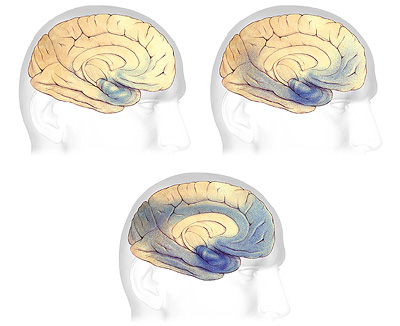Alzheimer’s is a type of dementia that affects memory, thinking and behavior. Symptoms eventually grow severe enough to interfere with daily tasks.
Understanding Alzheimer’s and dementia
- Alzheimer’s is the most common cause of dementia, a general term for memory loss and other cognitive abilities serious enough to interfere with daily life. Alzheimer’s disease accounts for 60-80% of dementia cases.
- Alzheimer’s is not a normal part of aging. The greatest known risk factor is increasing age, and the majority of people with Alzheimer’s are 65 and older. But Alzheimer’s is not just a disease of old age. Approximately 200,000 Americans under the age of 65 have younger-onset Alzheimer’s disease (also known as early-onset Alzheimer’s).
- Alzheimer’s is not a normal part of aging. The greatest known risk factor is increasing age, and the majority of people with Alzheimer’s are 65 and older. But Alzheimer’s is not just a disease of old age. Approximately 200,000 Americans under the age of 65 have younger-onset Alzheimer’s disease (also known as early-onset Alzheimer’s).
- Alzheimer’s has no current cure, but treatments for symptoms are available and research continues. Although current Alzheimer’s treatments cannot stop Alzheimer’s from progressing, they can temporarily slow the worsening of dementia symptoms and improve quality of life for those with Alzheimer’s and their caregivers. Today, there is a worldwide effort under way to find better ways to treat the disease, delay its onset, and prevent it from developing.
Symptoms of Alzheimer’s
The most common early symptom of Alzheimer’s is difficulty remembering newly learned information.
Just like the rest of our bodies, our brains change as we age. Most of us eventually notice some slowed thinking and occasional problems with remembering certain things. However, serious memory loss, confusion and other major changes in the way our minds work may be a sign that brain cells are failing.
The most common early symptom of Alzheimer’s is difficulty remembering newly learned information because Alzheimer’s changes typically begin in the part of the brain that affects learning. As Alzheimer’s advances through the brain it leads to increasingly severe symptoms, including disorientation, mood and behavior changes; deepening confusion about events, time and place; unfounded suspicions about family, friends and professional caregivers; more serious memory loss and behavior changes; and difficulty speaking, swallowing and walking.
People with memory loss or other possible signs of Alzheimer’s may find it hard to recognize they have a problem. Signs of dementia may be more obvious to family members or friends. Anyone experiencing dementia-like symptoms should see a doctor as soon as possible. If you need assistance finding a doctor with experience evaluating memory problems, your local Alzheimer’s Association can help. Earlier diagnosis and intervention methods are improving dramatically, and treatment options and sources of support can improve quality of life. Two helpful support resources you can tap into are ALZConnected, our messages boards and online social networking community, and Alzheimer’s Navigator, a web tool that creates customized action plans, based on answers you provide through short, online surveys.
Alzheimer’s and the brain
Microscopic changes in the brain begin long before the first signs of memory loss.
The brain has 100 billion nerve cells (neurons). Each nerve cell connects with many others to form communication networks. Groups of nerve cells have special jobs. Some are involved in thinking, learning and remembering. Others help us see, hear and smell.
To do their work, brain cells operate like tiny factories. They receive supplies, generate energy, construct equipment and get rid of waste. Cells also process and store information and communicate with other cells. Keeping everything running requires coordination as well as large amounts of fuel and oxygen.
Scientists believe Alzheimer’s disease prevents parts of a cell’s factory from running well. They are not sure where the trouble starts. But just like a real factory, backups and breakdowns in one system cause problems in other areas. As damage spreads, cells lose their ability to do their jobs and, eventually die, causing irreversible changes in the brain.
The role of plaques and tangles
Two abnormal structures called plaques and tangles are prime suspects in damaging and killing nerve cells.
- Plaques are deposits of a protein fragment called beta-amyloid (BAY-tuh AM-uh-loyd) that build up in the spaces between nerve cells.
- Tangles are twisted fibers of another protein called tau (rhymes with “wow”) that build up inside cells.
 Though autopsy studies show that most people develop some plaques and tangles as they age, those with Alzheimer’s tend to develop far more and in a predictable pattern, beginning in the areas important for memory before spreading to other regions.
Though autopsy studies show that most people develop some plaques and tangles as they age, those with Alzheimer’s tend to develop far more and in a predictable pattern, beginning in the areas important for memory before spreading to other regions.
Scientists do not know exactly what role plaques and tangles play in Alzheimer’s disease. Most experts believe they somehow play a critical role in blocking communication among nerve cells and disrupting processes that cells need to survive.
It’s the destruction and death of nerve cells that causes memory failure, personality changes, problems carrying out daily activities and other symptoms of Alzheimer’s disease.
Research and progress
In 1906, German physician Dr. Alois Alzheimer first described “a peciliar disease” — one of profound memory loss and microscopic brain changes — a disease we now know as Alzheimer’s.
Today, Alzheimer’s is at the forefront of biomedical research. Researchers are working to uncover as many aspects of Alzheimer’s disease and other dementias as possible. Some of the most remarkable progress has shed light on how Alzheimer’s affects the brain. The hope is this better understanding will lead to new treatments. Many potential approaches are currently under investigation worldwide.
